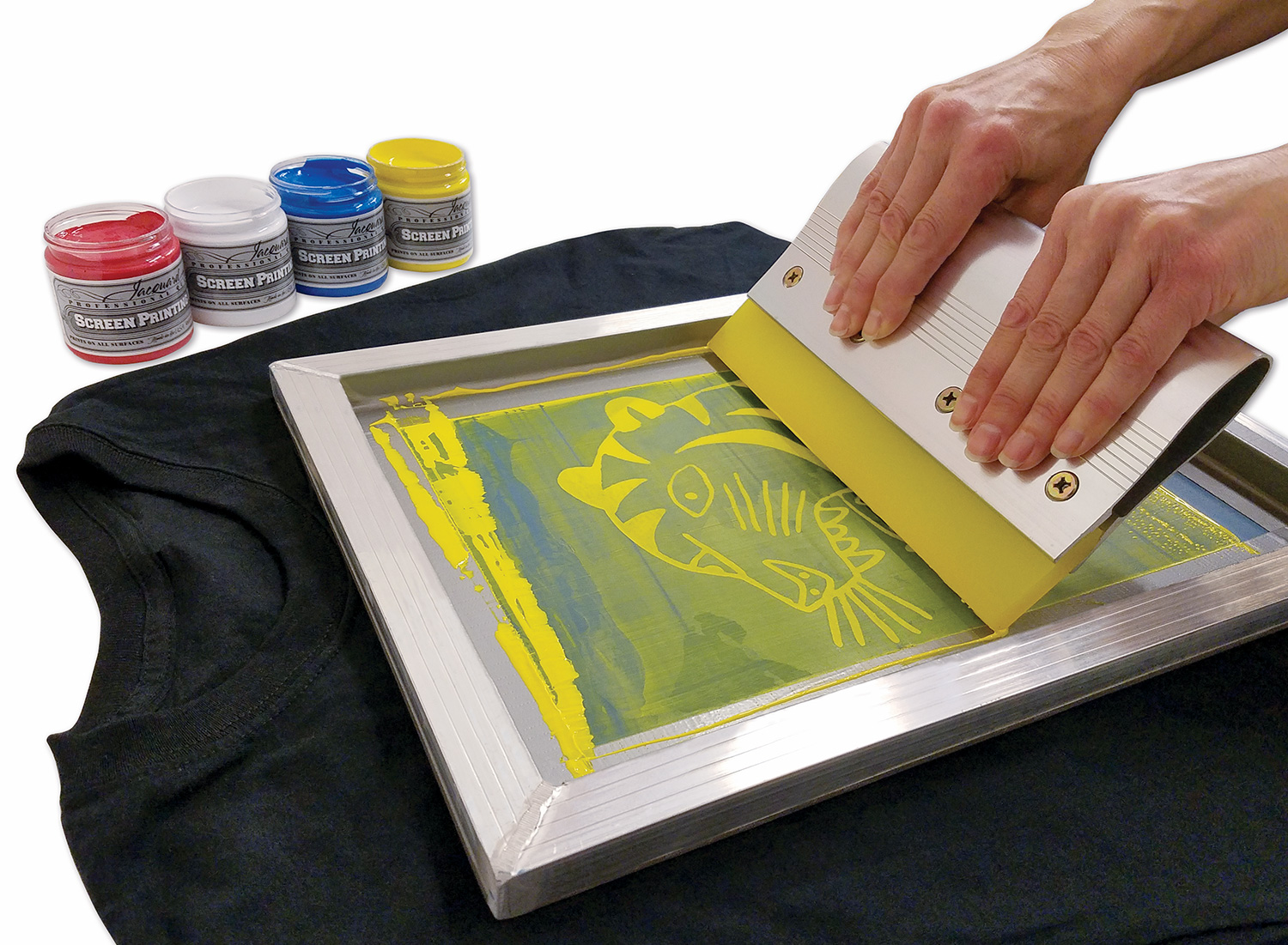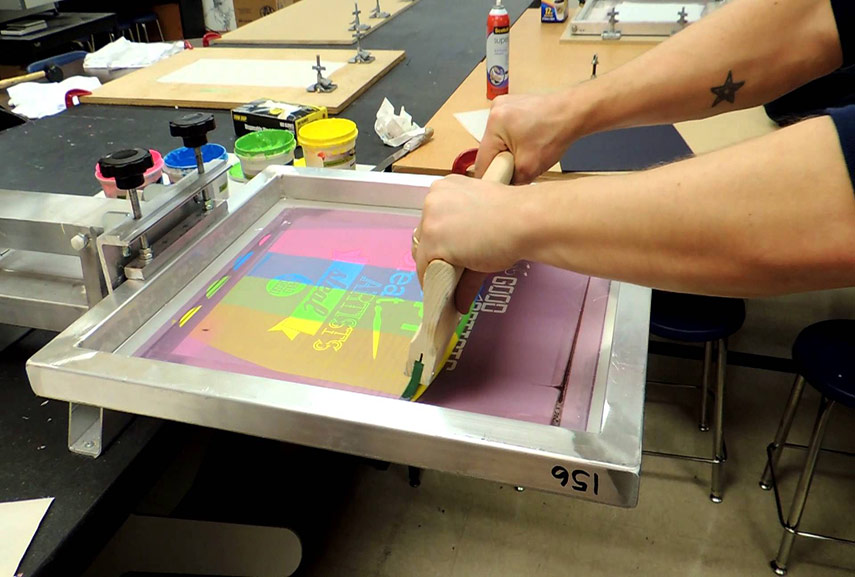Discover the Various Sorts Of Screen Printing Techniques for Your Following Job
Screen printing uses a diverse series of methods that can improve any type of innovative job. From typical methods like serigraphy to modern-day innovations such as direct-to-garment printing, each technique has its one-of-a-kind benefits. Specialty choices, consisting of eco-friendly and metal inks, present much more opportunities. Recognizing these techniques can significantly affect the last end result. However, the obstacle depends on picking one of the most ideal technique for certain needs and preferred impacts. What aspects should one consider?

The Fundamentals of Screen Printing
Screen printing might appear complicated, it is basically a straightforward process that involves transferring ink via a mesh screen onto different surfaces. The method starts with the production of a stencil, which defines the design to be printed. This pattern is affixed to a mesh screen, commonly made of polyester or nylon. As soon as the pattern is in place, ink is put on the screen and pressed via the mesh utilizing a squeegee, leading to the desired pattern being printed on the underlying material.
Screen printing can be performed on a wide variety of substratums, consisting of textile, plastic, and paper, making it a functional option for various jobs. The procedure permits elaborate styles and vivid colors, making it popular in sectors such as art, fashion, and advertising. Comprehending these basics equips people with the fundamental understanding needed to explore more innovative techniques in screen printing.
Typical Screen Printing Techniques
Standard screen printing techniques have been used for centuries, preserving the workmanship and virtuosity of this technique. This strategy uses a mesh screen to transfer ink onto a substrate, such as textile or paper, allowing for resilient and dynamic designs. The procedure starts with creating a stencil, which blocks certain locations of the screen to manage where the ink will be applied.
One prominent method is serigraphy, commonly utilized for creative prints and limited editions. Another is the use of water-based inks, which are environment-friendly and give a soft feeling on textiles - 10:9 Design Screen Printing Texas. Furthermore, traditional methods can consist of manual printing, where craftsmens use ink with a squeegee, guaranteeing precision and interest to information
These methods continue to be valued in the sector for their tactile quality and the one-of-a-kind structures they produce, attracting both creators and consumers who appreciate the heritage of screen printing.
Digital Screen Printing Innovations
As the demand for faster production and customization in the printing industry has actually surged, electronic screen printing developments have arised as a game-changer. This modern technology blends conventional screen printing techniques with digital processes, permitting for fast prototyping and detailed designs that were formerly challenging to accomplish. One considerable advancement is the intro of direct-to-garment (DTG) printing, which promotes top quality, full-color prints on various fabrics without the need for screens. Furthermore, advancements in ink formulas have actually caused green choices that maintain vivid colors while lessening ecological effect. The usage of automated systems even more simplifies production, lowering labor prices and enhancing accuracy. These technologies not only accommodate tiny set orders and individualized styles yet likewise permit quicker turnaround times, making them ideal for organizations concentrated on conference client demands in a busy market. Digital screen printing, subsequently, stands for a vital advancement in the domain name of printing methods.
Specialized Screen Printing Approaches
Discovering specialty screen printing methods discloses a varied range of strategies that press the limits of imagination and functionality in the printing industry. Among these, glow-in-the-dark inks provide an one-of-a-kind aesthetic impact, making styles come to life in low-light problems. Metallic inks, recognized for their shimmering coating, add a touch of high-end to printed materials. Another cutting-edge approach is discharge printing, which eliminates dye from the textile as opposed to adding ink, causing a soft, classic feel. High-density printing produces a raised appearance on the surface, boosting responsive interaction. In addition, water-based inks are gaining appeal for their dynamic colors and reduced environmental impact. Each of these specialty techniques deals with certain layout demands, making it possible for artists and brand names to create standout items that resonate with their target markets. By leveraging these methods, services can raise their screen printing projects to brand-new elevations, guaranteeing remarkable impacts.
Eco-Friendly Screen Printing Options
Environmentally friendly screen printing alternatives are acquiring traction as the industry changes in the direction of sustainability. Lasting ink options and making use of eco-friendly materials are key parts in lowering the environmental effect of the printing procedure. By embracing these methods, screen printers can contribute to a much more sustainable future while preserving top quality results.
Sustainable Ink Selections

Biodegradable Products Use
As the screen printing industry progresses, the consolidation of eco-friendly products is becoming significantly vital for eco conscious practices. Producers and developers are now discovering inks and substrates made from natural, renewable energies that disintegrate more effectively than standard counterparts. These biodegradable alternatives decrease plastic waste and lessen ecological effect, straightening with the expanding need for lasting get more info items.
Usual examples consist of water-based inks and natural cotton materials, both of which decrease unsafe chemicals and promote eco-friendliness. Brand names that embrace these products often improve their market charm, bring in customers that focus on sustainability. As understanding of environmental problems proceeds to increase, the shift towards naturally degradable products in screen printing is most likely to gain energy, promoting a greener market criterion.
Choosing the Right Method for Your Project
Just how can one figure out one of the most appropriate screen printing technique for a details project? The decision pivots on numerous aspects, consisting of the product to be printed on, the intricacy of the layout, and the wanted production volume - 10:9 Design Screen Printing Texas. Direct-to-garment printing is perfect for detailed layouts with countless shades, while standard screen printing excels for larger runs of less complex graphics.
In addition, factor to consider of the end-use of the published item is vital. For outside applications, techniques that supply sturdiness and weather resistance, such as plastisol ink, may be liked. Conversely, environmentally-conscious tasks might take advantage of biodegradable materials or water-based inks.
Ultimately, recognizing the project's one-of-a-kind needs permits an informed selection, making sure both aesthetic charm and practical long life. By reviewing style complexity, material compatibility, and manufacturing range, one can effectively pick one of the most proper screen printing method to satisfy their task's objectives.
Regularly Asked Concerns
What Is the Background of Screen Printing?
Screen printing came from ancient China around 1000 ADVERTISEMENT, evolving through Japan and Europe. By the 20th century, it ended up being prominent in business art and fashion, reinventing how styles were generated and dispersed around the world.

Just how Do I Prepare Artwork for Screen Printing?
To prepare artwork for screen printing, one have to ensure high resolution, make use of an appropriate color setting, create separate layers for each and every shade, and convert text to describes, assuring compatibility with the printing procedure and wanted result.
What Products Are Ideal for Screen Printing?
The best products for screen printing include premium inks, sturdy displays, and suitable substrates like cotton, polyester, or blends. In addition, using suitable emulsion and mops can improve the printing procedure and results.
Can I Screen Publish at Home?
Yes, screen printing in the house is possible. With the appropriate materials, setup, and methods, people can develop high-quality prints. However, mindful consideration of work space and tools is necessary for effective outcomes.

What Are Usual Blunders in Screen Printing?
Common blunders in screen printing consist of improper direct exposure times, insufficient ink consistency, misalignment of displays, not enough cleaning of materials, and neglecting to check prints. These mistakes can jeopardize the top quality and accuracy of the end product.
Screen printing might seem facility, it is essentially an uncomplicated procedure that involves transferring ink through a mesh screen onto numerous surfaces. As the need for faster production and customization in the printing industry has surged, electronic screen printing innovations have arised as a game-changer. Discovering specialized screen printing approaches reveals a diverse selection of techniques that push the limits of creativity and functionality in the printing industry. The best products for screen printing consist of premium inks, resilient screens, and ideal substrates like cotton, polyester, or blends (10:9 Design Embroidery). Common mistakes in screen printing include improper exposure times, insufficient ink consistency, imbalance of screens, not enough cleaning of products, and neglecting to evaluate prints